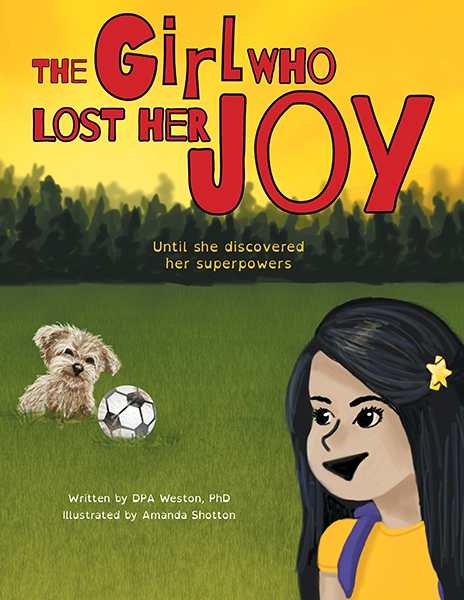The Girl Who Lost Her Joy
The Girl Who Lost Her Joy is a hopeful book that shows that people with anxiety disorders don’t need to suffer alone.
A joyful young girl’s life is turned upside down when she develops an anxiety disorder after a tragic loss in her family. Based on a true story, DPA Weston’s The Girl Who Lost Her Joy shows how community support and getting in touch with the inner resources, or “superpowers,” that all people possess can be the key to recovery.
Raised in a happy family made up of a mother and father who live apart, an “annoying” younger brother, a pet dog, and a large extended family of loving grandparents, aunts, uncles, and cousins, the unnamed girl has everything she needs for a good life, including a good self-image. She is thankful for all she has, including the many friends with whom she enjoys playing and having sleepovers.
One June day, something terrible happens to the girl’s aunt. The thought that she will never again see her aunt makes her very sad. Nothing can cheer her up, not even wonderful summer activities or the thought of starting middle school in September.
The book gives a clear description of the symptoms that the once joyful girl experiences, including a lack of interest in the people and activities that used to make her happy; the desire to stay alone in her room; a worsening performance at school; nightmares and problems sleeping; panic attacks that make breathing difficult; and excessive preoccupation with germs that leave her washing her hands until they bleed.
It also describes how her mother’s care and concern, professional help, a correct diagnosis, and a supportive community help the girl to regain her enthusiasm for life. Discovering her inner “superpowers” and talents, she grows into a sensitive young woman who finds that her greatest joy comes from helping others.
Written in a friendly, conversational tone, the book presents an uncomplicated, easy-to-understand, and moving account of how a life-changing event can affect young people, especially those of middle school age. Having such a resource available might help readers to recognize some of the symptoms in themselves or in their friends and to encourage readers to seek help. It is appropriate for solo reading and for group discussions in the classroom and at home.
Amanda Shotton’s bright, colorful illustrations bring the text to life, reflect its emotional tone, and make it appealing as a read-aloud book for a younger age group. The compelling title highlights a main characteristic of those who suffer from anxiety disorders: the loss of joy. It also offers hope that joy can be recovered by developing the “superpowers” needed to navigate turbulent and confusing life events.
Parents and teachers will find the book’s questionnaire, printable self-test, and chart describing how to differentiate between normal anxiety and a true anxiety disorder useful for enhancing their understandings of the problem. Suggestions for helping someone with an anxiety disorder, along with a list of resources and contact information for various support groups and organizations, are also helpful.
The Girl Who Lost Her Joy is a hopeful book that shows that people with anxiety disorders don’t need to suffer alone—that there are resources available in the family, the community, and especially within themselves that can help them to recover and thrive.
Reviewed by
Kristine Morris
Disclosure: This article is not an endorsement, but a review. The publisher of this book provided free copies of the book and paid a small fee to have their book reviewed by a professional reviewer. Foreword Reviews and Clarion Reviews make no guarantee that the publisher will receive a positive review. Foreword Magazine, Inc. is disclosing this in accordance with the Federal Trade Commission’s 16 CFR, Part 255.

